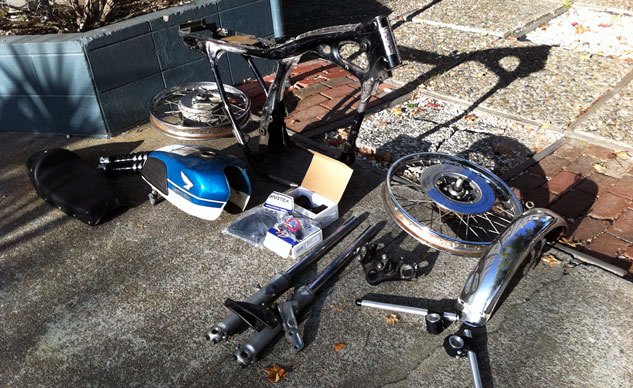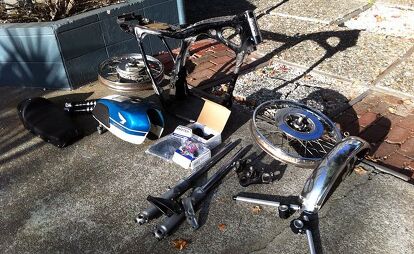Skid Marks - Vintage Bike Cognition Disorder
“Oh, yeah!” came the soft English accent through my phone’s speaker. “Looks like you seized a piston! I’ll fix it right up for ya.”
That sounds like bad news, sure, but you know you’ve hit rock bottom when such a pronouncement from famed machinist Mike Crowther of the Engine Dynamics Company is good news. Yeah, you know what I mean, sucker. “Whew!” I thought. “At least the rods are okay! I really got off easy that time!” Hey what’s $500 and eight hours sitting on a garage floor if it gets me another 900 miles of slow, uncomfortable, bad-handling riding? Cheap at twice the price.
We have different, much-lower standards of performance and reliability for vintage bikes, not unlike how we treat three-legged dogs or the children of celebrities. Hey, needing new pistons and all the expensive, time-consuming work that goes along with installing them is “no big deal,” according to my dirty-fingered gearhead buddies. But if I owned a Ninja 250 that needed new slugs, my first call would be to a local salvage yard to see if they wanted a free parts bike. “It’s parked in the left-hand median between the Cesar Chavez exit and the 280 split. The keys are in it, but I’ll mail you the title and the drain plug, which I just found in the litterbox.”
You won’t make that call about a vintage bike. Oh, no. That would be too merciful. The value of a 1970-ish CB350 when it’s in pieces on the floor of said dirty-fingered friend’s garage is probably about 73 cents more than a seized 2002 Kawasaki EX250, but can you put a pricetag on emotional value? On all the hours spent driving around picking up parts, all the keystrokes and mouseclicks wasted, all the endless hand-wringing about what carburetor size to order? Can you put a value on all the times you had to ask your spouse to drive you and your motorcycle somewhere (or, more likely, home from somewhere)? It’s better that you don’t, unless you want to lie awake wondering why you own something that cost more than a Lamborghini Gallardo with the performance of a 1988 Volkswagen Vanagon.
If you are nodding your head while reading this, it’s possible you’ve got Vintage Bike Cognition Disorder. You may think you’re being perfectly rational when you spend $500 to rebuild a motor with the same camshaft and big-bore kit you used last time, because there’s no way it’ll burn the exhaust valve a third time, not if it knows what’s good for it. Classic VBCD. Currently, there is no treatment for this very serious condition, but at least we’ve finally got an excuse for this irrational and self-destructive condition. We may even qualify for State Disability and handicap plates.
You may be surprised to read (or not, if you’re a follower of mental-health news) that the American Psychiatric Association will be including VBCD in the upcoming DSM-VI. Here is the proposed diagnostic listing:
Vintage Bike Cognition Disorder
Vintage Bike Cognition Disorder is characterized by more than one vintage-motorcycle buying decision. There are three types of VBCD:
1. VBCD 1 Disorder, in which the primary symptom presentation is manic, or rapid (daily) episodes of riding and depression.
2. VBCD 2 Disorder, in which the primary symptom presentation is recurrent depression accompanied by occasional riding episodes (a milder state in which the symptoms are not severe enough to cause marked impairment in social or occupational functioning or need for hospitalization, but are sufficient to be observable by others, especially the guy at the parts counter).
3. Motorcyclothymic Disorder, a chronic state of cycling between riding and depressive episodes that do not reach the diagnostic standard for VBCD (APA, 2000, pp. 388–392). This is mostly observed in owners of later-model vintage motorcycles, especially BMW /5 series and newer. This includes all Sportster models.
Riding episodes are characterized by:
A. A distinct period of abnormally and persistently elevated, expansive, or irritable mood, lasting at least 15 miles (or any distance if hospitalization is necessary).
B. During the period of mood disturbance, three (or more) of the following symptoms have persisted and have been present to a significant degree:
(1) Increased self-esteem or grandiosity, especially after watching “Cafe Racer” on Discovery channel.
(2) Decreased need for sleep (e.g., feels rested after only three hours of sleep), especially on Sunday mornings.
(3) More talkative than usual or pressure to keep talking about nickel-plating or wheel building.
(4) Distractibility (i.e., attention too easily drawn to unimportant or irrelevant external stimuli, especially if combined with purchasing pipe wrap).
(5) Increase in goal-directed activity (like attending an annual vintage ride) or psychomotor agitation, although this may be caused by the vibration inherent in pre-unit Twins.
(6) Excessive involvement in pleasurable activities that have a high potential for painful consequences, including riding a vintage motorcycle more than 25 miles in a week, operating a high-speed wire wheel drunk, or eating at Waffle House.
VBCD-related Depression is characterized by:
Depressed mood most of the day for more days than not, for at least two years (or duration of a single project, not exceeding 27 years), and the presence of two or more of the following symptoms that cause clinically significant impairment in social, work, or other important areas of functioning:
1. Posting to vintage-bike discussion groups even if the subject lacks an operable vintage motorcycle.
2. Insomnia caused by late-night internet shopping for parts.
3. Low energy or fatigue due to hand-polishing aluminum while watching the Locomotive Channel.
4. Low self-esteem related to driving a Toyota Camry to the BSA club’s monthly breakfast.
5. Poor concentration or difficulty making rational decisions (i.e. should I sell my Norton?).
6. Feelings of hopelessness, especially when kick-starting a vintage Single.
Treatment:
There is no known treatment. On occasions, victims have been distracted for sustained periods by liberal applications of fun, inexpensive, easy-to-ride motorcycles, especially if the subject is denied access to friends with trailers or vans. More often, and sadly, the condition persists for years, until the patient is either broke, divorced, or passes out and suffocates under a pile of old magazines. Some sufferers transition to Fantasy Motorcycle Ownership Disorder, where they self-identify as the owner of a motorcycle that hasn’t run since they were in high school.
If you think you or a loved one may be suffering from VBCD, call the National Center for Motorcyclists and Snowmobilers Mental Health at 734/205-0555. You can also donate to assist the NCMSHB – cash, Paypal, check, credit card or motorcycle parts, especially valve-stem guides for a 1957 or 1958 Triumph Cub.
*If you need to know which carburetor size you should order for your 1968-1974 CB350, try this handy formula I developed through many months of trial and error: measure the manifold opening in millimeters and multiply that number by the number of hours you’ve spent worrying whether you’ll order the wrong size, then divide by the number of hours it will take you to figure out how to install them using the crappy cables, adapters and air filters you’ll get with the kit and multiply by 1,000. Write a check for that amount to your favorite charity and sell the bike.
Gabe Ets-Hokin is a freelance motorcycle journalist who has been fired by some of the best publications in the industry. His opinions are not the opinions of Motorcycle.com or any rational, thinking being or entity. He asserts that satire is a defense to libel; sadly, he is unaware that what he writes isn’t really that funny.
More by Gabe Ets-Hokin


































Comments
Join the conversation
I donno... I crave a nice 84-86 Honda CB700SC Nighthawk. Does that count? Does anyone make an EFI kit for it? That would be the perfect motorcycle for me.
Heh, heh...Guilty...Great piece!